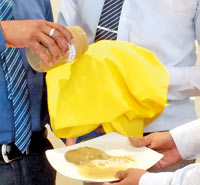Say goodbye to smelly and sweaty shirts with new stain and water-resistant fabrics
Say goodbye to smelly and sweaty shirts with new satin and water-resistant fabrics
Very soon the shirt you wear won’t need a wash for a long time while also serving as a protection against the transmission of diseases.

From left: Dr. (Ms) Thamara Dias, Head, Technology Division, NSF; Prof. R.M.G. Rajapakse, Senior Professor in Chemistry, Peradeniya University; Somasiri Manage, Manager - Product Development and Innovation, Textured Jersey Lanka PLC and Ms. N. Wickramarachchi, Scientific Officer -NSF.
Produced abroad? Not really. That technology, which has been around for a while globally ,
has been re-developed for industrial use by a local textiles firm involved in the production of textiles for export.
Recently the University of Peradeniya (UoP) and Textured Jersey Lanka PLC (TJL,) backed by Pacific Textiles Hong Kong and Brandix Lanka signed a Memorandum of Association (MoU)
to ‘develop textiles of the future’ through the use of Superhydrophobic Textiles (SHT) and Textiles with Antimicrobial properties (TAP) technologies, both developed through nanotechnology.
These efforts are being promoted by the National Science Foundation (NSF), a leading state agency involved in supporting science based research and development, technology promotion and providing grants, to help link the industry with universities in an effort to advance technology to become commercially viable and be part of the new Fourth Industrial Revolution.
The MoU was signed last week by Prof. Upul B. Dissanayake, Vice Chancellor, UoP and Sriyan de Silva Wijeratne, CEO, TJL Group at the TJL factory at the Seethawaka International Industrial Park,
Avissawella at an event where NSF officials – Dr. (Ms) Thamara Dias, Head of Technology Division; and J.G. Shanthasiri and Ms. N Wickramarachchi, Scientific Officers -, and the Business Times were also present.

The fabric being tested
Both these innovations are expected to boost TJL products. SHT manufactured with nanotechnology repels moisture and has stain resistant properties.
Textiles with TAP properties resist the transmission of diseases. According to wikepedia, a superhydrophobic coating is a nanoscopic surface layer that repels water.
Droplets hitting this kind of coating can fully rebound in the shape of column or pancake, according to one scientific explanation.
Another WWW (worldwide web) explanation said that SHT while being easy care, comfortable to wear and breathable, also has a large role for materials that can, t
o a substantial degree, demonstrably prevent the growth of bacteria.
TAP has been described in WWW sources as fabrics and textiles with fiber-based substrates to which antimicrobial agents have been applied at the surface, or incorporated into the fibers,
rendering a product that kills or inhibits the growth of microorganisms. Prof. R.M.G. Rajapakse, Senior Professor in Chemistry, University of Peradeniya who heads the team in nanotechnology projects and who was present at the TJL factory,
said they have commenced research for TJL on these projects with the NSF grant of Rs. 7.2 million spread over a 3-year period. The two projects on the textile products have now been completed, he said.
He told the Business Times that they have developed SHT fabrics which do not absorb water. Normally textiles are moisture prone and thus with water, dirt sticks.
If the clothes are not waterish, no dirt will stick on it and thus the clothes needn’t be washed, saving time and energy.
Prof. Rajapakse said SHF would also greatly benefit the earth and the environment as there is no need for extensive soap or washing powder use.
“What we did was to modify the surface of the textiles in such a way that water does not get absorbed into the clothes. Then it also has stain resistance properties”.
To prove that this is not all ‘talk’, the scientists demonstrated the process: When mud, water and dirt were poured into SHF textiles it did not stick onto the clothes.
The other textiles they have developed is called ‘textiles with anti-microbial properties’. The Peradeniya don said that most of the diseases are transmitted by microorganism and wet cotton is a very good culture to transmit microorganism.
Fabrics with antimicrobial properties have been developed in their labs with the help of funds granted by NSF. The university worked on these projects for more than one year and modified the available technology for present day use.
The MOU, he said is intended to do three more projects with the same company. Funding for these projects is coming from the industry itself.
Dr. (Ms) Dias said that the NSF offers grants to projects that involve advanced technology which are beneficial to the people. Products with such technology would not only create new markets but also enhance its marketability. The university research team on these projects included Dr. S. S. Gunathilaka, Senior Lecturer, Dept. of Chemistry.


.png)








_67.png)







.png)
.png)
